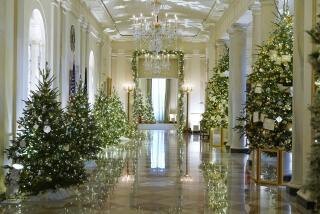Exhibit Marks White House’s Bicentennial
- Share via
WASHINGTON — From Alaska to Alabama and from Beijing to Buenos Aires, one image represents the United States--the White House.
It is a center of political power. It is a symbol of a nation. It is a home to Presidents and their families.
“I pray Heaven to bestow the best of Blessings on this House and all that shall hereafter inhabit it. May none but honest and wise Men ever rule under this roof,” John Adams wrote to his wife Abigail on Nov. 2, 1800, a day after he became the first chief executive to live in the White House.
Adams’ letter is among the memorabilia in an exhibit at the Octagon Museum entitled “The White House 1792-1992: Image in Architecture.”
The exhibit includes original documents, drawings, projects, stone fragments, photographs and portraits marking the 200th anniversary of the laying of the building’s cornerstone.
In the adjacent headquarters of the American Institute of Architects are archival drawings of the decorative and structural details of the White House compiled by the Historic American Buildings Survey.
The Residence Act of 1790, which established the capital city, authorized the Commissioners of the District of Columbia to “provide suitable buildings for the accommodation of Congress and of the President.”
George Washington, who never lived in the official residence, selected the site in 1791. Irish-born architect James Hoban, who won the $500 competition to design the residence, helped lay the cornerstone Oct. 13, 1792.
Adams lived in the official residence for only four months before Thomas Jefferson won the presidency.
James Madison, the third president to live there, was with the Army when the British burned the home Aug. 23, 1814, during the War of 1812. Dolley Madison is credited with saving a number of items, including a portrait of Washington.
The items at the exhibit, open until April 12, include:
* A pen-and-ink drawing of a facade for the residence, believed to have been Thomas Jefferson’s anonymous entry in the design competition.
* Two manuscripts with the names of stonecutters and bricklayers for the building, including artisans recruited in Edinburgh, Scotland, to cut and set the stone of the exterior.
Hoban was commissioned to rebuild the White House a year after it was burned, and the residence has continued to grow and change with its inhabitants.
“Through two centuries, the White House has been continually building, a structure in which new ideas are likely to replace old ones before the old ones are put into effect,” architectural historian William Seale wrote in the exhibit’s catalogue.
Among the changes:
* Theodore Roosevelt enlarged the executive mansion, and rebuilt the East Terrace as a guest entrance in 1902.
* In 1909, the West Wing offices doubled in size, with the first presidential Oval Office at its center.
* Major repairs to West Wing offices after a fire Christmas Eve 1929.
* In 1934, Franklin Delano Roosevelt expanded the West Wing office building and added central air conditioning.
* From 1935 to 1945, underground storage and facilities were added as was the East Wing offices, which included a bomb shelter.
* Major renovation during the Harry S. Truman Administration, 1948-52, which forced the Truman family to live in Blair House, the official guest house across the street from the White House.
* A project to remove the exterior paint and restore the building’s stone began in 1978 and is expected to be completed in 1993.
“The White House 1792-1992: Image in Architecture” is on display at the Octagon Museum and the adjacent American Institute of Architects through April 12. The exhibit is co-sponsored by the American Architectural Foundation and the White House Historical Assn., with the cooperation of the Smithsonian Institution.
More to Read
Sign up for Essential California
The most important California stories and recommendations in your inbox every morning.
You may occasionally receive promotional content from the Los Angeles Times.













